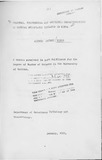| dc.description.abstract | Contagious caprine pleuropneumonia (CCP?) is an acute disease of goats characterized by- acute fibrinous pneumonia and pleuritis. !£hree Mycoplasma species namely, Mycoplasma mycoides subsp. mycoides (Y-goat), M. mycoides subsp. capri and Mycoplasma species strain F38 are the main aetiological agents.
In Kenya Mycoplasma mycoides subsp. mycoides (Y-goat) and Mycoplasma strain F38 have been clearly documented to cause CCPP. In an investigation
to establish whether mycoplasma other than the two mentioned above cause CCPP in Kenya, 34 strains were isolated from CCPP cases and characterized culturally, biochemically and serologically. By the growth inhibition and indirect-epi-immunoflu- rescent tests, 17 of the strains were conclusively identified as Mycoplasma species strain F38, eight
as Mycoplasma arrinini, five as Mycoplasma ovipneumoniae and four as Mycoplasma mycoides subsp. mycoides (Y-goat),
All the F38 strains metabolized glucose aerobically and anaerobically with acid production. Stronger reactions were however, observed in cultures incubated anaerobically. Mannose and galactose were readily metabolized with acid production by all the strains except four which poorly metabolized
(xiii)
galactose and two which never metabolized mannose at all. Xylose was readily metabolized by 13 strains while cellobiose and sorbitol were either poorly metabolized or not at all by most of the strains.
Two strains strongly metabolized these two sugars.
Of the four media tested for their ability to support growth of the 1*38 group, two media yielded the best growth. These were medium B (Modified Hayflick) and Newings tryptose medium. Visible colonies appeared after an average of three days following inoculation of media. The colonial morphology had the characteristic fried egg appearance of mycoplasma. Medium B without yeast extract and SP4 medium poorly supported the growth of the F38 group. Growth on SP4 medium was slow and it normally took seven days of incubation before the colonies beoame visible on plates. In this medium the colonies lacked the typical fried egg appearance characteristic of mycoplasma.
Hyperimmune sera produced in rabbits immunized with membranes from Mycoplasma species strain F38 were compared with sera produced by immunization with whole cells. The growth inhibition and the indirect-epi-immunofluorescent tests showed that the membrane antigen produced antisera were of lower quality than that produced with whole organism. | en_US |



